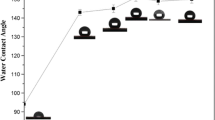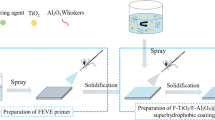Abstract
In this study, a durable, reusable, effective and large-area molding method was proposed to fabricate hierarchical structures on the CF/PEEK composite surface. The hierarchical structures were fabricated using a combination of sandblasting and anodizing treatments on the metal surface. Subsequently, a hot-pressing process was adopted for producing structures that matched the metal templates. The rough surface was modified by (Heptadecafluoro-1,1,2,2-tetradecyl)trimethoxysilane with low surface energy to obtain superhydrophobicity. Scanning electron microscopy was utilized to observe the surface morphologies and structure. The chemical composition and roughness were analyzed by FT-IR spectroscopy and the laser microscopy, respectively. Wettability was characterized through contact angle measuring instruments, and static and dynamic sliding contact angles were obtained to be 158.23° and 8.38°, respectively. After the abrasion test, the CF/PEEK composite surface still maintained reasonable mechanical stability. Comparing with the untreated sample, CF/PEEK superhydrophobic surface exhibited excellent anti-icing performance with freezing time increasing from 54 to 514 s at − 20° and icing adhesion strength reducing to 30.5 kPa. Although the fabrication of composite surface with water repellency presented here is useful for anti-icing, it can also be applied in other applications that require superhydrophobic surfaces.













Similar content being viewed by others
References
Iveković A, Novak S, Lukek M, Kalin M (2015) Aqueous electrophoretic deposition of bulk polyether ether ketone (PEEK). J Mater Process Technol 223:58–64
Hasan MMB, Cherif C, Foisal ABM, Onggar T, Hund RD, Nocke A (2013) Development of conductive coated Polyether ether ketone (PEEK) filament for structural health monitoring of composites. compos sci technol 88:76–83
Chen M, Ouyang L, Lu T, Wang H, Meng F, Yang Y et al (2017) Enhanced bioactivity and bacteriostasis of surface fluorinated polyetheretherketon. ACS Appl Mater Interfaces 9(20):16824–16833
Andersson LO, Golander CG, Persson S (1994) Ice adhesion to rubber materials. J Adhes Sci Technol 8(2):117–132
Ayres J, Simendinger WH, Balik CM (2007) Characterization of titanium alkoxide sol–gel systems designed for anti-icing coatings: ii. Mass loss kinetics. J Coat Technol Res 4(4):473–481
Zhu W, Liu H, Yan W, Chen T (2017) The fabrication of superhydrophobic PTFE/UHMWPE composite surface by hot-pressing and texturing process. Colloid Polym Sci 295(5):759–766
Yao X, Song Y, Jiang L (2011) Applications of bio-inspired special wettable surfaces. Adv Mater 23(6):719–734
Cao Y, Huang J, Yin J (2016) Numerical simulation of three-dimensional ice accretion on an aircraft wing. Int J Heat Mass Trans 92(3):34–54
Jung S, Tiwari MK, Doan NV, Poulikakos D (2012) Mechanism of supercooled droplet freezing on surfaces. Nat Commun 3:615
Jin M, Shen Y, Luo X, Tao J, Xie Y, Chen H, Wu Y (2018) A combination structure of microblock and nanohair fabricated by chemical etching for excellent water repellency and icephobicity. Appl Surf Sci 455:883–890
Kulinich SA, Farzaneh M (2004) Alkylsilane self-assembled monolayers: modeling their wetting characteristics. Appl Surf Sci 230:232–240
Futamata M, Gai X, Itoh H (2004) Improvement of water-repellency homogeneity by compound fluorine–carbon sprayed coating and silane treatment. Vacuum 73:519–525
Marin J, Kennedy KJ, Eskicioglu C (2010) Characterization of an anaerobic baffled reactor treating dilute aircraft de-icing fluid and long term effects of operation on granular biomass. Bioresour Technol 101:2217–2223
Tourkine P, Merrer ML, Quere D (2009) Delayed freezing on water repellent materials. Langmuir 25:7214–7216
Alizadeh A, Yamada M, Li R, Shang W, Otta S, Zhong S, Ge L, Dhinojwala A, Conway KR, Bahadur V, Vinciquerra AJ, Stephens B, Blohm ML (2012) Dynamics of ice nucleation on water repellent surfaces. Langmuir 28:3180–3186
Dotan A, Dodiuk H, Laforte C, Kenig S (2009) The relationship between water wetting and ice adhesion. J Adhes Sci Technol 23:1907–1915
Watson GS, Watson JA (2004) Natural nano-structures on insects—possible functions of ordered arrays characterized by atomic force microscopy. Appl. Surf. Sci. 235(s 1–2):139–144
Gao X, Jiang L (2004) Biophysics: water-repellent legs of water striders. Nature 432(7013):36
He Y, Jiang C, Cao X, Chen J, Tian W, Yuan W (2014) Reducing ice adhesion by hierarchical micro-nano-pillars. Appl Surf Sci 305:589–595
Weng C, Wang F, Zhou M, Yang D, Jiang B (2018) Fabrication of hierarchical polymer surfaces with superhydrophobicity by injection molding from nature and function-oriented design. Appl Surf Sci 436:224–233
Lu Y, Sathasivam S, Song J, Chen F, Xu W, Carmalt CJ, Parkin IP (2014) Creating superhydrophobic mild steel surfaces for water proofing and oil-water separation. J Mater Chem A 2:11628–11634
Cully P, Karasu F, MÜLler L, Jauzein T, Leterrier Y (2018) Self-cleaning and wear-resistant polymer nanocomposite surfaces. Surf Coat Technol 348:111–120
Kulinich SA, Farzaneh M (2009) Ice adhesion on super-hydrophobic surfaces. Appl Surf Sci 255:8153–8157
Xue C, Li Y, Zhang P, Ma J, Jia S (2014) Washable and wear-resistant superhydrophobic surfaces with self-cleaning property by chemical etching of fibers and hydrophobization. ACS Appl Mater Interfaces 6(13):10153–10161
Yu M, Gu G, Meng W, Qing F (2007) Superhydrophobic cotton fabric coating based on a complex layer of silica nanoparticles and perfluorooctylated quaternary ammonium silane coupling agent. Appl Surf Sci 253(7):3669–3673
Wang H, Hu Z, Zhu Y, Yang S, Kai J, Zhu Y (2017) Toward easily enlarged superhydrophobic materials with stain-resistant, oil-water separation and anti-corrosion function by a water-based one-step electrodeposition method. Ind Eng Chem Res 56(4):933–941
Zhu T, Cai C, Duan C, Zhai S, Xu J (2015) Robust polypropylene fabrics super-repelling various liquids: a simple, rapid and scalable fabrication method by solvent swelling. ACS Appl Mater Interfaces 7(25):13996–14003
Nakajima A, Abe K, Hashimoto K, Watanabe T (2000) Preparation of hard super-hydrophobic films with visible light transmission. Thin Solid Films 376(1–2):140–143
Sun M, Luo C, Xu L, Ji H, Ouyang Q, Yu D et al (2005) Artificial lotus leaf by nanocasting. Langmuir 21(19):8978–8981
Sheng J, Zhang M, Xu Y, Yu J, Ding B (2016) Tailoring water-resistant and breathable performance of polyacrylonitrile nanofibrous membranes modified by polydimethylsiloxane. ACS Appl Mater Interfaces 8(40):27218–27226
Zhan Y, Ruan M, Li W, Li H, Hu LY, Ma F, Yu Z, Feng W (2017) Fabrication of anisotropic PTFE superhydrophobic surfaces using laser microprocessing and their self-cleaning and anti-icing behavior. Colloid Surf A-Physicochem Eng Asp 535:8–15
Yu D, Zhao Y, Li H, Qi H, Yuan X (2013) Preparation and evaluation of hydrophobic surfaces of polyacrylate-polydimethylsiloxane copolymers for anti-icing. Prog Org Coat 76(10):1435–1444
Liu J, Wang J, Mazzola L, Memon H, Barman T et al (2018) Development and evaluation of poly(dimethylsiloxane) based composite coatings for icephobic applications. Surf Coat Technol 349:980–985
Yang C, Fang Y, Zhao K, Li C, Yang X, Zhou H et al (2015) Preparation principle of super-hydrophobic surfaces by phase separation. J Macromol Sci Part B 54(8):20
Li H, Li X, Luo C, Zhao Y, Yuan X (2014) Icephobicity of polydimethylsiloxane-b-poly(fluorinated acrylate). Thin Solid Films 573:67–73
Wang N, Tang L, Tong W, Xiong D (2018) Fabrication of robust and scalable superhydrophobic surfaces and investigation of their anti-icing properties. Mater Des 156:320–328
Zhang Q, Jin B, Wang B, Fu Y, Zhan X, Chen F (2017) Fabrication of a highly stable superhydrophobic surface with dual-scale structure and its antifrosting properties. Ind Eng Chem Res 56(10):2754–2763
Pan L, Hu J, Lv Y, Ma W, Ding W, Wang Y et al (2018) Modification of Ti–6Al–4V plates with schiff base complex and adhesive performance of Ti–6Al–4V/PEEK. Mater Des 144:271–280
Shen Y, Tao J, Tao H, Chen S, Pan L, Wang T (2015) Anti-icing potential of superhydrophobic Ti6Al4V surfaces: ice nucleation and growth. Langmuir 31:10799–10806
Alizadeh A, Yamada M, Li R, Shang W, Otta S, Zhong S et al (2012) Dynamics of ice nucleation on water repellent surfaces. Langmuir 28(6):3180–3186
Hao P, Lv C, Zhang X (2014) Freezing of sessile water droplets on surfaces with various roughness and wettability. Appl Phys Lett 104(16):161609
Zobrist B, Koop T, Luo BP, Marcolli C, Peter T (2007) Heterogeneous ice nucleation rate coefficient of water droplets coated by a nonadecanol monolayer. J Phys Chem C 111:2149–2155
Hejazi V, Sobolev K, Nosonovsky M (2013) From superhydrophobicity to icephobicity: forces and interaction analysis Scientific reports-UK 2194 (2013)
Sarkar DK, Farzaneh M (2009) Superhydrophobic coatings with reduced ice adhesion. J Adhes Sci Technol 23:1215–1237
Acknowledgements
This work was supported by Jiangsu-UK Industrial Challenge Programme (No. BZ2017063) and National Key Research and Development Program (No. 2017YFB0703301).
Author information
Authors and Affiliations
Corresponding author
Additional information
Publisher's Note
Springer Nature remains neutral with regard to jurisdictional claims in published maps and institutional affiliations.
Rights and permissions
About this article
Cite this article
Pan, L., Wang, F., Pang, X. et al. Superhydrophobicity and anti-icing of CF/PEEK composite surface with hierarchy structure. J Mater Sci 54, 14728–14741 (2019). https://doi.org/10.1007/s10853-019-03956-0
Received:
Accepted:
Published:
Issue Date:
DOI: https://doi.org/10.1007/s10853-019-03956-0




